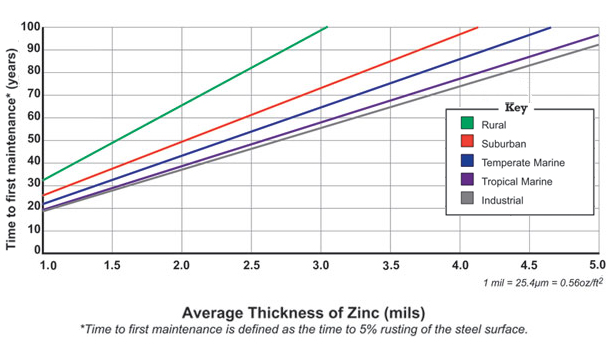Why Galvanize?
The Benefits
Hot-dip galvanizing confers numerous benefits that are important to architects and owners.
▶ Durability. Because of its superior ability to stand up to harsh environments, hot-dip galvanizing has been widely utilized in such demanding fields as the petrochemical, industrial, and power/utility industries and on bridge and highway projects. The durability is a function of abrasion resistance, uniform protection, and complete coverage. A unique characteristic of the hot-dip galvanized coating is the development of metallurgically bonded, abrasion-resistant intermetallic layers with high bond strengths up to 3,600 psi developed naturally during a metallurgical reaction between the iron in the steel and zinc in the kettle. The top layer is pure zinc, which has the ductility to minimize damage to the coating. Compared to other coatings with lower bond strengths, many of which range between 300-600 psi, hot-dip galvanizing's abrasion resistance protects against damage from transport, erection, and service.
Hot-dip galvanizing also provides uniform protection. During the metallurgical diffusion reaction in the galvanizing kettle, the galvanized coating grows perpendicular to all surfaces, providing the same thickness throughout—on flat surfaces as well as corners and edges, where damage is typically experienced. Other coatings, particularly those applied by brush or spray, can thin at corners and edges, which become weak points for corrosion. Further, the steel is fully submerged, with molten zinc coating all surfaces, even the interior of hollow and tubular structures, where corrosion can accelerate as humidity and condensation occur. Hollow structures that are painted have no corrosion protection on the inside at all. Further, the immersion process fully coats all fasteners which, because they are used at connection points, are particularly critical to structural integrity.
It is important to note that while galvanizing is commonly used to connote all types of zinc coatings, this is an erroneous assumption. Not all zinc coatings have the same properties, and physical, chemical, and corrosion resistance can vary widely. Compared to metallizing, zinc-rich painting, sheet galvanizing, electroplating, and zinc (mechanical) plating, hot-dip galvanizing provides more uniform coverage and a significantly higher metallurgical bond.
▶ Versatility. Complex fabrications and forms of virtually any shape and size from bolts to beams can be hot-dip galvanized. Unlike other corrosion protection systems, the process is factory controlled and not dependent on temperature or humidity. There are no curing delays as zinc solidifies upon withdrawal from the bath, and the entire hot-dip process can be completed, and the elements shipped and erected in a day's time. Alternatively, galvanized steel can be stored on site for years as the coating is not susceptible to UV degradation or damage from the elements, enabling owners to maintain an inventory for easy replacement, saving time and often, money.
▶ Low maintenance. More than a hundred years of third-party testing of hot-dip galvanized steel in industrial, rural, suburban, tropical marine, and temperate marine environments together with statistical methods, and neural network technology enabled Dr. Gregory Zhang of Teck Metals Ltd. to formulate the Zinc Coating Life Predictor (ZCLP) to approximate the service life of hot-dip galvanized coatings. This predictor allows users to plug in parameters for their specific environment to determine an estimated time for first maintenance, considered at 5 percent rusting of the base steel surface, which means 95 percent of the zinc coating is still intact—the point at which initial maintenance is recommended. As can be seen in the accompanying chart (see the online version of this course), hot-dip galvanized structural steel provides 72-73 years of life to first maintenance even in the most corrosive atmosphere—industrial.

▶ Efficiency. Uncomplicated steel structural frame designs can be developed quickly and cost efficiently. Pre-fabricated and galvanized off-site at indoor plants, the steel members move quickly through the galvanizing process without interruption by inclement weather for a quick production phase. Their light weight relative to materials like concrete makes steel beams less costly to transport and reduce on-site crane and caisson requirements. Generally speaking, steel-framed systems can be constructed at 10 to 20 percent savings over concrete alternatives.1










